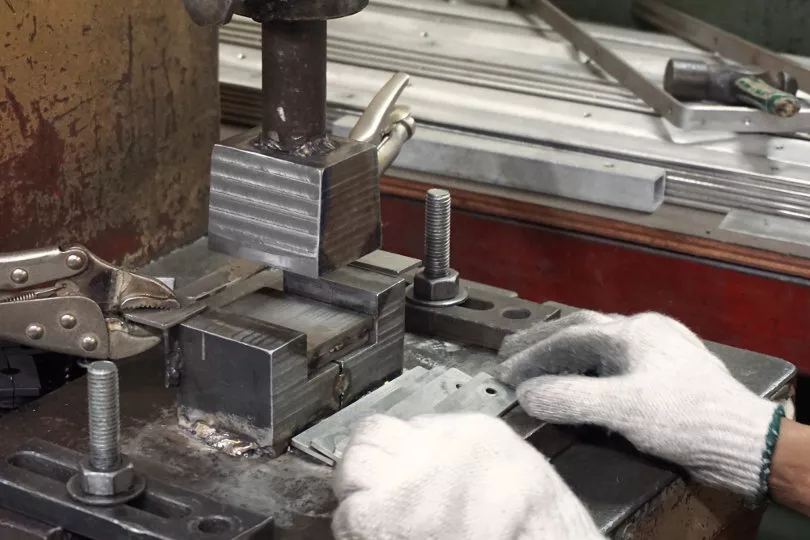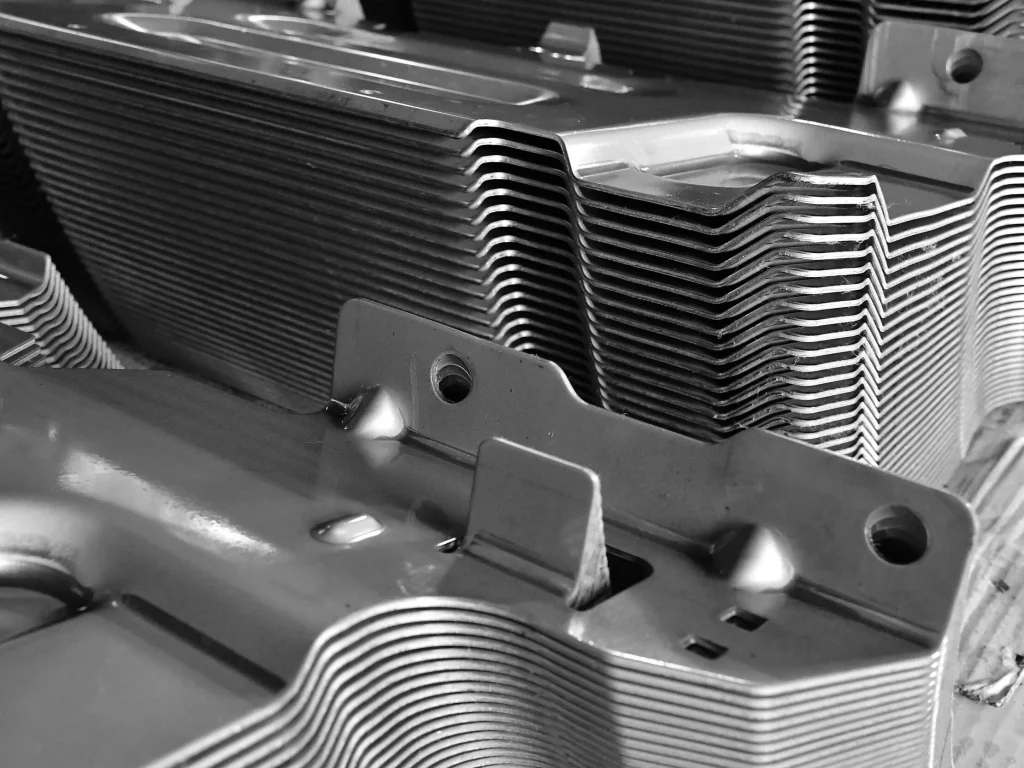Metal stamping is turning sheet metal into valuable parts or assemblies. Metal stamping is a cold-forming process that uses dies and presses to bend sheet metal into variously shaped pieces. The process involves placing a flat sheet of metal between the die sections of the press and using pressure to form and cut the material into the final shape needed for the product or component. Except for specialized processes, metal stamping does not use thermoforming techniques.
This article introduces the metal stamping process, its development history, metal stamping and the types of stamping dies, the advantages of metal stamping, discusses the design process, and explains the different kinds of stamping operations and their applications.
What is metal stamping?
Metal stamping, also known as punching. It is a low-cost, high-speed manufacturing process, which is a complex process. The primary production process involves placing a flat metal sheet into a stamping press where the tool and die surfaces form the metal into the desired shape. The entire process includes several metal forming techniques: punching, blanking, bending, embossing, embossing, and flanging.
Before the material can be stamped and formed, the tooling must be designed using CAD/CAM engineering techniques. The design must ensure that each press meets the design requirements of the final part. Stamping operations are suitable for short or long production runs and are performed with other metal-forming functions.
As the global marketplace grows, stamping technology allows for the rapid production of large quantities of complex parts, and the demand for stamped parts continues to grow in the automotive, aerospace, medical, and other markets.

History of Metal Stamping
The earliest known use of metal stamping technology was found in the 7th century B.C. when the Lydians used the stamping technique to mint coins. This metal stamping method for coins involved placing a metal sheet between a die with one image and a stamp with another to create the currency. This method of stamping was performed by purely manual means of striking.
The rapid development of stamping technology originated from the invention of a metal press called the screw press by the German silversmith Max Schwa in 1550. The screw press was so large that it required 12 workers to operate it.
It began when manufacturers adopted stamping technology to make bicycle parts. The manufacturers concerned found the application of the technology inexpensive and efficient. They began to apply stamping technology to the production of components on a large scale, making metal stamping technology play a fundamental role during the industrial revolution.
The 20th century saw the industrial production of Ford automobiles in the United States, with Henry Ford using metal stamping to process Model T parts. However, during part of the 20th century, the development of stamping technology remained in the summary of experience and has yet to be made real breakthroughs. The primary analytical tool used was the classical forming mechanic’s theory, and the research focused only on sheet metal stamping performance and forming mechanics, which did not address and meet the needs of the automotive industry.
In 1960, various new forming techniques emerged, especially the introduction of forming limit diagrams (FLD), which promoted the coordinated development of sheet metal properties, forming theory, forming technology, and quality control and became a milestone in the history of stamping technology development.
The early development of the finite element method and CAD technology in the 1980s and numerical simulation and counting machine application technology in the 1990s made the field of stamping reach rapid development and practicality as a tool for material deformation behavior research and process design. It moved the traditional forming technology from science experience and started a high-speed development.
Especially in modern times, the combination of highly paid technologies in methods and systems with new technologies, computer technology. The penetration and cross-fertilization of information technology, current measurement and control technology, etc., into the stamping field, have promoted the formation and development of modern advanced stamping technology. It has also established the position of sheet metal stamping in the field of parts manufacturing today.
What types of metal stamping are there?
There are several types of metal stamping. Different types of metal stamping use other technologies to produce finished parts with high-quality standards, and the following is detailed information on the types of operations related to metal stamping.
Progressive die stamping
Progressive die stamping has multiple stations, each with a unique function. Progressive die stamping uses a series of stamping stations to feed a sheet metal strip into a reciprocating press with a progressive stamping die. The die moves with the press, and as the press moves downward, the die closes to stamp the metal and form the part. The metal moves horizontally to the next station as the media moves up. The entire process is reciprocal from one station to the next, with each station performing specific functions, including forming, punching, bending, and cutting the metal, with the final stop separating the newly manufactured part from the rest of the metal.
Progressive stamping offers the advantages of a fast turnaround and creating repetitive, uniform parts. It also has the lowest labor costs for each stamping type. Each step in the process performs a different cutting, bending, or stamping operation on the metal to gradually achieve the desired end product shape and design, a tight circle with a limited amount of wasted scrap. For this reason, progressive die stamping is also the ideal solution for metal parts with complex geometries.
Four-slide stamping
Four-slide stamping is a metal-forming process, and this technique is best suited for making complex components with many bends or twists. Four-slide stamping is also known as multi-slide or four-way stamping. It uses four sliding tools instead of one vertical slider; each simultaneously bends the metal into the desired shape. As the material is fed into the four-slide, two slides or punches strike the workpiece horizontally to deform it, and no dies are used. Four-slide stamping allows for easy design changes and adjustments when a project requires many parts with different bends at relatively low cost and fast production rates.
Deep Draw Stamping
Deep drawing is a technique that uses a punch to feed a sheet of metal into a die. It involves drawing the sheet metal into the die through the hole to form it, and when the depth of the drawn part exceeds its diameter, the method is called “deep drawing.” This type of forming is ideal for projects that require extreme depths and cuts with multiple diameters. Deep drawing uses less raw material than other stamping processes, making it a cost-effective alternative to turning. It is only suitable for the production of simple parts in high-volume production.
Types of metal stamping die
The dies used for metal stamping operations can be classified according to materials, processes, and techniques.
Classification by stamping process
1. Punching process is called punching die, including drop die, punching die, cutting die, notching die, cutting die, trimming die, cutting edge die and fine punching die, etc.
2. Bending process is called a bending die, including press bending dies, pull bending dies, twist dies, roll edge dies, etc.
3. Deep drawing process is called deep drawing die, including single-sided deep drawing die, double-action deep drawing dies, thinning deep drawing die, etc.
4. The forming process is called forming die, including undulation creating die, flanging die, shaping die, expansion die, indentation die, etc.
5. Volume stamping process has an embossing die and cold extrusion die.
Classification according to the degree of process combination
1. Single process die: In the stamping process of the stamped parts, the die has only one stamping process.
2. Composite die: There is only one station, and two or more stamping processes are completed simultaneously at the same station on the same press.
3. Progressive die (also called a continuous die): two or more stations in the direction of the feed of the blank, on a press with one stroke, where two or more stamping processes are gradually completed at different positions.
4. Transfer die: Combining the characteristics of single process die and progressive die, it mainly adopts a robotic transmission system, thus realizing rapid transfer within the product die, the production efficiency of the product is greatly improved, the production cost of the product is reduced, the material cost is saved, and also the quality is stable.
Classification according to the form of mold guidance
1.Open die: no guide die.
2. Column die: the upper and lower die is guided by a guide column and sleeve.
3. Guide plate dies: the die is guided by a guide plate.
Classification according to the degree of automation in die stamping
It can be divided into manual, semi-automatic, and automatic die.
Classification according to production adaptability
According to the production batch and other factors, the die can be divided into general-purpose die and special punching die.
Classification by die material
It can be divided into metal punching dies, rubber punching dies, plastic punching dies, and powder metallurgy punching dies.

Advantages of metal stamping
Some of the benefits of stamping compared to other processes are. The die guarantees the accuracy of the size and shape of metal stamping parts. Usually, the surface quality of stamped parts is not compromised, and the life of the die is generally longer, so the quality of metal stamping is consistent. Details of various sizes and complex shapes can also be processed. The material’s cold deformation and hardening effect during metal stamping make the strength and stiffness of metal stamping higher. Nowadays, mechanization and automation of metal stamping simplify operations and significantly increase production efficiency. This is because metal stamping mainly relies on dies and stamping equipment to complete the process. The stroke time of ordinary presses can reach tens of strokes per minute, high-speed presses can reach hundreds or even thousands of strokes per minute, and each stamping stroke can be perforated. Metal stamping usually produces no chips or scrap due to the process, consumes very little material, and is a cold-forming process that requires no other heating equipment. Therefore, it is a material-saving and energy-saving method of machining parts, and the cost of metal stamping parts is low. These are the advantages of metal stamping, so does it have disadvantages?
The disadvantage of stamping is the high cost of the press. Dies must be acquired or created; producing custom metal stamping dies is a longer pre-production process. If the design must be changed during production, the die is also tricky to change.
Applications of Metal Stamping
Metal stamping is a popular manufacturing process in which highly specialized computer-aided drafting and manufacturing of metal parts with tight tolerances in materials such as steel, copper, stainless steel, and aluminum are used. Metal stamping can also produce high-quality, resilient, heavy-duty parts quickly and efficiently. You can use metal stamping to manufacture products for different industries. For example
- Automotive
- Agricultural parts
- Aerospace
- Electronic products
- Household appliances
- Lighting
- Health care
- Defense
- Telecommunications
Summary
This article has presented an understanding of metal stamping operations, history of development, types of processes, types of dies used, advantages and disadvantages, etc. For more information on related services, please get in touch with us for [email protected]
When your industry requires high-quality precision parts, you need a stamping company that meets the most stringent standards. Elimold is an ISO 9001:2015 registered company, and we produce over 1 million highly detailed parts per month, even for the most technologically advanced applications. Please visit our services page or request a quote online to learn more about our stamping services. If you have any questions, please get in touch with Elimold today.

